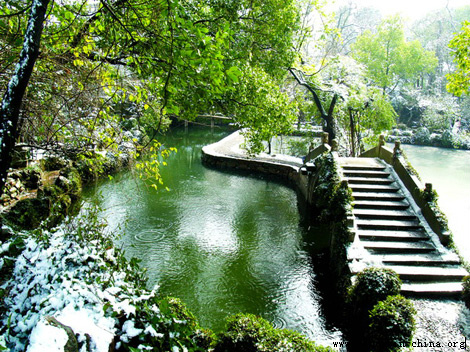| Home > Living In China |
Food Culture in China
Table Manners
Dining culture is deeply rooted in China, a country that pays great attention to courtesy. Round tables are popular for Chinese to have dinner, because they can seat more people and are convenient for chat. A dinner must start after all the people are seated. Even if someone is late, people at the table must wait. When all the people are seated, the host should give an opening speech, after which people can start eating. During a dinner, the host is usually very active and frequently asks the guests to eat as much as they can.

Different from western dinners that people eat only their own dishes, Chinese usually put dishes in the middle and share them. Everyone has a bowl of rice. When one picks something from a plate, it’s polite to put it in his/her bowl first instead of eating it directly. During a formal Chinese dinner, the guests should not eat up all the dishes on the table. Otherwise, the host may feel embarrassed for not preparing enough. In addition, instead of going Dutch, a Chinese dinner is usually paid by one person. Eating in Chinese restaurants is still relatively cheaper in spite of the inflation. Scores of yuan (about 10 dollars) covers one person’s normal meal in most Chinese restaurants.
On Chopsticks
China is the hometown of chopsticks. The culture of chopsticks has a long history in China. The tradition of using chopsticks as tableware was introduced to many other countries in the world such as Vietnam, Japan, North Korea and South Korea.
The invention of chopsticks reflects the wisdom of Chinese ancient people. A pair of chopsticks, though look simple, can nip, pick, rip and stir food. Nowadays, chopsticks are considered to be lucky gifts for marriage and other important ceremonies.
Chinese Cuisine Culture
Chinese cuisine is rich and varied in taste and appearance. It requires that dishes should be attractive in color, vivid in shape and appealing in taste. Stemming from a wide range of regional tastes, minority ethnic groups, royal court dish, feudal official dish, temple food and local special dishes, Chinese cuisine has distinctive flavor which enjoys an international reputation. The multiple regions and cultures within China only add to the richness of the nation’s food.
Compared to royal court dish, feudal official dish and temple food, regional dishes are the main part of Chinese cuisine. Chinese regional dishes can be classified into four major categories, namely,
Shandong (Lu) cuisine, Szechuan (Chuan) cuisine, Guangdong (Yue) cuisine and Jiangsu (Su) cuisine.
Cuisine Lu mainly refers to Shandong cuisine, also known as northern dish, which include the delicacies of Beijing, Tianjin and the northern part of China.
Beijing Duck
Cuisine Chuan refers to dishes in the southwest part of China, of which dishes in Chengdu, Chongqing and South Chuan are representatives. Cuisine Chuan is famous for its spicy, tingling, and strong tastes.
Cuisine Su, also known as Cuisine Huaiyang, refers to dishes in the southeast part of China.
Mapo Tofu
Cuisine Yue, also known as Canton Cuisine, has the feature of delicate but tasty, fresh but free from vulgar, tender but not crude, and greasy but not fat. Cuisine Yue has strong seasonal character, light in summer and autumn, while rich in winter and spring. Most Chinese restaurants abroad are Yue restaurants.
Chinese Tea Culture
Tea can help to abandon distracting thoughts and nature one’s soul, which is compatible to the oriental philosophical thinking of tranquility and indifference to fame and the ideas of mould one’s temperament through retrospection of Buddhism, Taoism and Confucianism. Tea ceremony, as etiquette of mundane life with the theme of tea, is also a means for people to cultivate his character by brewing, enjoying and tasting tea.

China is the origin of the tea ceremony. Tea-tasting was regarded as a way to cultivate one’s body and mind in Tang dynasty or even before. A record in the book The Record of What Mr. Feng Sees and Hears written in Tang dynasty says that tea ceremony was popular and that both the nobles and the aristocrats were fond of tea. It is the earliest record about tea ceremony in the existing documents. Tang lvwen (772A.D—811A.D) made a vivid description about the elegance of tea parties and the appeal of tea-tasting in Preface to Tea Parties in March, 3. During Tang and Song dynasty, great attention on the process of tea-tasting such as tea houses, courtesies and way of brewing had already been attached and some customs and ceremonies of tea-tasting had already come into being. What’s more, tea parties had also developed into tea parties in palace, in temple and tea parties of scholars. The history of tea ceremony in China is hundreds years or even a thousand years earlier than that in Japan. Tea ceremonies in China show different spirits in different historic stage, so it concentrates more on the spirit of tea instead of the form. There are varieties of tea, differing in shapes and tastes, but all demonstrate the spirit of tea ceremony of tranquility, respect, pleasance and reality.
Chinese Wine Culture
Chinese wine drinking has been taken a quite important role in Chinese people’s life for a long time, from ordinary people to kings.
When to drink
Ancient Chinese drank the Realgar Wine on May 5th, and the Chrysanthemum Wine on September 9th. On the fifteenth day of the first moon, during the Lantern Festival, watching the lantern show or admiring the full moon to celebrate the Mid-Autumn Festival, they would liven up drinking. Wine was intimately connected with most Chinese men of letters. During good times, the Chinese like to "sing and drink because life is brief" whereas during bad times they wonder "why relieve sorrows since wine just matters".
The banquets of ancient emperors and kings could not take place without wine. Every sort of spirits vessel thus became an important kind of sacrificial object subscriber. Modern Chinese still follow the custom of drinking wine during dinners. Wine exists in all kinds of banquets and friends’ get-togethers.
Custom
 more
moreWeb Dictionary
Primary&secondary
Beijing National Day School
Beijing Concord College of Sino-Canada
Brief Introduction of BCCSC Established in the year 1993, Huijia School is a K-12 boarding priva...Beijing Huijia Private School





 print
print  email
email  Favorite
Favorite  Transtlate
Transtlate 







